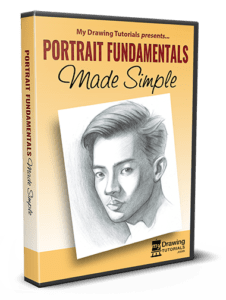
If you wanna learn more about portrait drawing, check out my “Portrait Fundamentals Made Simple” course.
It’s a very beginner-friendly course that walks you through all the basics of portraiture, from constructing a basic head, facial proportions, drawing the features, and finally drawing a realistic portrait step-by-step.
Lesson Transcript
Knowing how to construct a simplified head using the Loomis Method is a great start. However, this head is still far from being a complete portrait.
So in the next few lessons, we’re going to learn how to develop this head further to bring it closer to an actual realistic head.
We’ll be adding in simple features as well as the planes of the head to build it into a three-dimensional object.
But in order to do that, we’ll have to become familiar with the basic proportions of the face. So let’s go over that real quick.
Overall Dimensions of the Head
From the front view, the head can fit into a box 3 and 1/2 units tall and 3 units wide. Although the head fit snugly into the box at the top to bottom, there’s actually a little bit of room along the side.
This tells us that the head is a rectangular shape with the height being slightly more than the width.
You might be wondering why the head is 3 and 1/2 units tall. Where did that number come from? Well, it turns out, it’s the result of the “Rule of Thirds”.
As you might recall, the “Rule of Thirds” states that the face can be divided into 3 equals sections. And when we look at this diagram here, we can see that at work.
The first unit of height corresponds with the bottom of the nose. The second unit corresponds with the brow line. And the third unit corresponds with the hair line… with the hair area making up the remaining 1/2 unit.
So as you can see, by constructing the head using the methods laid out in the previous lessons, your head will automatically fall into these proportions.
Now let’s go over the proportions of the facial features.
Proportions of the Eyes
Concerning positioning, the eyes will fall right at the midway point of the height.
To figure out how far apart to space the eyes, we would simply take the width of the head, which is measured from one side to the other (without including the hair) and divide this distant into 5 equal parts.
The section in the middle will represent the distance between the eyes. The two sections on the side of it, will represent the eyes themselves. And the two sections on the out edge will represent the space between the eyes and the side of the face.
OK, that was quite a mouthful! So let me summarize it this way: The eyes are 1 eye-width apart, with 1 eye-width of space on each sides.
Proportions of the Nose
Regarding positioning, the nose will fall right at the center of the face. That’s obvious enough.
And we already know from the “Rule of Thirds” where the bottom of the nose will be so that’s easy as well.
The width of the nose will be equal to 1 eye-width. So when drawing, we would simply take the space between the eyes and bring it down to find the width of the nose.
Proportions of the Lips
Regarding position, the lips will be 1/3 of the way down from the nose. So if we divided the distance between the bottom of the nose and the chin into thirds, the center of the lips will be right there.
The width of the lips will be slightly smaller than the distance between the pupils.
Proportions of the Ears
Front the front view, the ears will sit between the browline and the bottom of the nose.
From the side view, the ears will sit in the lower back quadrant of the head. This is most easily seen in the simplified head. In this diagram, the ear will fit into this quadrant here. This is one reason why it’s so helpful to divide the side of the head into sections when drawing a simplified head.
Side View of the Head
From the side view, the head can also be put into a box. The dimension of this box will be slightly different from the front view.
The height of the box will still be 3 and 1/2 units, as that won’t change even when you look at the head from the side.
However, the width of the head will be slightly larger at 3 and 1/2.
That is to say, the head will be more square-shaped when viewed from the side.
Most of the facial features will be concentrated towards the front, with the eyes, nose, and lips fitting within the first unit of the width.
The corner of the lips will correspond with the pupils. The edge of the lips and chin will be inline with the edge of the forehead.
And finally, the ear will fall in the third unit of width and lies between the brow line and bottom of the nose.
Remember, these proportions represents an average and that most individual faces will vary slightly from these measurements. But knowing them will still be very useful.


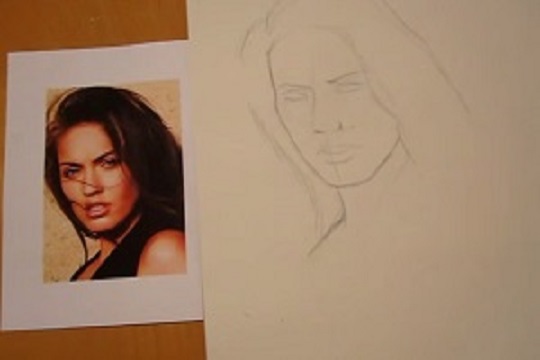
![Drawing Realistic Portrait Series [1 of 8] – Intro & Materials](https://mydrawingtutorials.com/wp-content/uploads/2012/08/Portrait-Lesson-1.jpg)
![Drawing Realistic Portrait Series [2 of 8] – The Fundamentals of Shading](https://mydrawingtutorials.com/wp-content/uploads/2012/08/Portrait-Lesson-2.jpg)

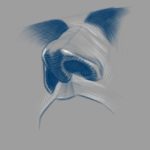
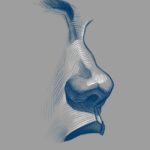
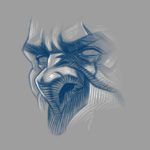
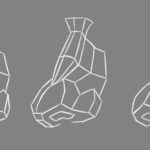

You have and incredible talent for teaching! I’ve been looking for months watching every portrait tutorial I could find and finally today …
During your 5 min video I got it!
Thank you. I will promote your amazing talent wherever I go and yo all I meet!
Thank you so much, Sue! I’m glad you enjoyed the lessons 🙂